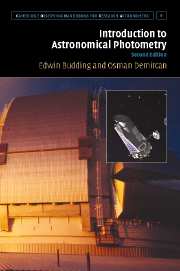Book contents
- Frontmatter
- Contents
- Preface to first edition
- Preface to second edition
- 1 Overview
- 2 Introduction
- 3 Underlying essentials
- 4 Themes of astronomical photometry
- 5 Practicalities
- 6 Procedures
- 7 Basic light curve analysis
- 8 Period changes in variable stars
- 9 Close binary systems
- 10 Spotted stars
- 11 Pulsating stars
- Appendix
- Author index
- Subject index
11 - Pulsating stars
Published online by Cambridge University Press: 13 August 2009
- Frontmatter
- Contents
- Preface to first edition
- Preface to second edition
- 1 Overview
- 2 Introduction
- 3 Underlying essentials
- 4 Themes of astronomical photometry
- 5 Practicalities
- 6 Procedures
- 7 Basic light curve analysis
- 8 Period changes in variable stars
- 9 Close binary systems
- 10 Spotted stars
- 11 Pulsating stars
- Appendix
- Author index
- Subject index
Summary
Introductory background
The eclipsing binaries and spotted stars discussed in the previous three chapters still represent only about a quarter of all variables. The largest class of variable stars are those having some inherent physical variation in luminosity, as distinct from an effect of geometry. They are often referred to as pulsating, sometimes vibrating, stars: words suggesting the physical cause of the variation. Although, as noted before, all stars would vary over a sufficiently long timescale, an appreciable intrinsic variation of luminosity accessible to human inspection implies a very short period against general stellar time frames, giving perspective to such terminology. There are examples whose light pattern repeats in measurably the same form for many cycles, with a periodicity of comparable constancy to that of eclipsing variables. Others show varying degrees of chaotic behaviour. In ‘irregular’ cases, the light level wanders up and down with no pattern or predictability. But many show quasi-periodic variations of a ‘semiregular’ nature. Some examples of the different light curves are shown in Figure 11.1.
Spectroscopy shows that the variations in apparent magnitude are linked with changes of radius. By studying the Doppler shifts of absorption lines in the regular cepheid type variables (prototype δ Cephei), it was deduced that the star oscillates inward and outward in the same period as the brightness cycle, the star being faintest not far from, but somewhat before, the time when it is smallest.
- Type
- Chapter
- Information
- Introduction to Astronomical Photometry , pp. 375 - 410Publisher: Cambridge University PressPrint publication year: 2007



